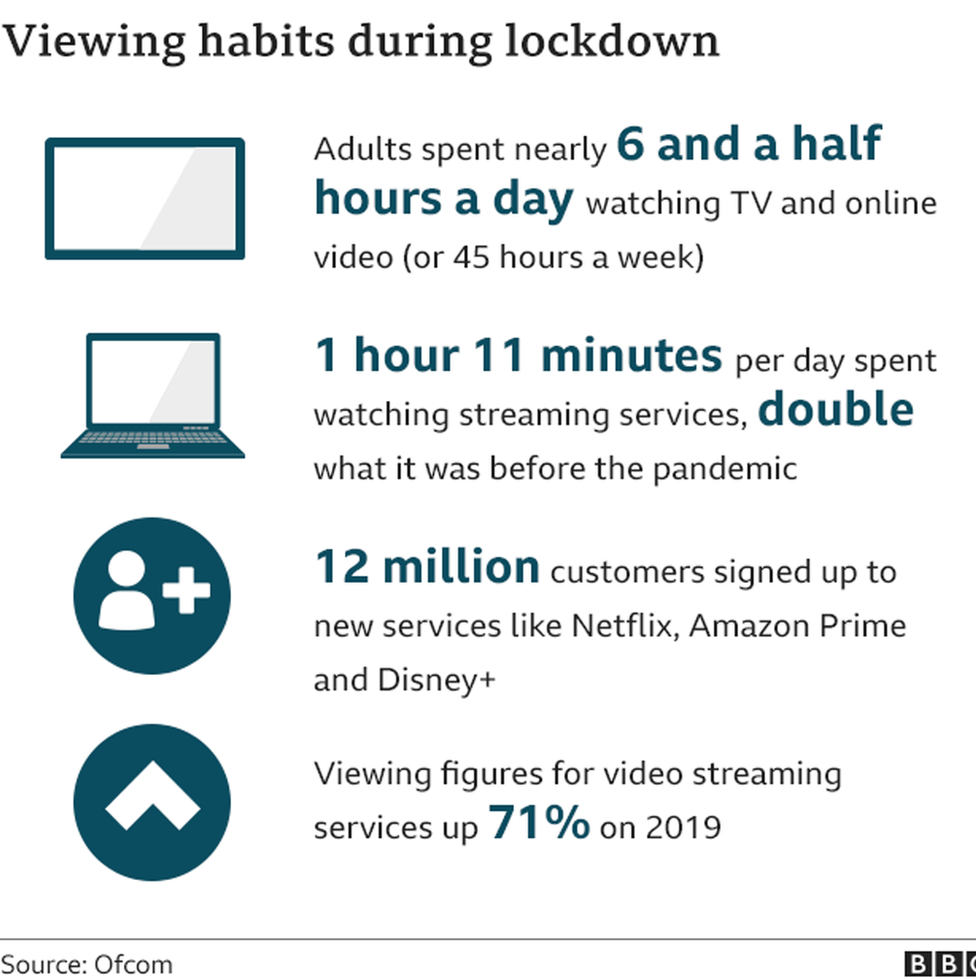Lockdown measures enforced due to the Covid-19 pandemic brought about a surge in TV watching and online streaming, according to media watchdog Ofcom.
Its annual study into UK media habits suggested adults – many stuck indoors – spent 40% of their waking hours in front of a screen, on average.
Time spent on subscription streaming services also doubled during April.
At the height of lockdown, adults spent an average of six hours and 25 minutes each day staring at screens.
Screen time overall was up almost a third (31%) on last year.
People watched streaming services, such as Netflix, Amazon Prime Video and Disney+, for one hour 11 minutes per day, and 12 million people joined a service they hadn’t used previously. Three million of these viewers had never subscribed to any service before.
The majority signed up to Netflix and Amazon Prime Video, although Disney+ overtook Now TV as the third most popular paid-for streaming platform.
Older viewers, who typically watch more traditional broadcast TV, increased their use of streaming platforms, too.
One third of 55-64-year-olds, and 15% of people aged 65+ used subscription services in the early weeks of lockdown.
The study, entitled Media Nations 2020, suggested that as lockdown measures eased towards the end of June, the uplift in streaming services held firm – 71% up on the same time last year.
This figure also included people viewing more non-broadcast content on platforms like YouTube and gaming sites.
And more than half of UK adults (55%) with new streaming subscriptions said they will keep them and spend the same amount of time watching streamed content in future.
- ITV halts Coronation Street, Emmerdale, Lorraine, Loose Women filming
- Emily Eavis: Glastonbury 2021 will be ‘a double celebration’
- TV in lockdown: How shows are coping without a studio audience
- EastEnders to return with shorter episodes
However in July, Netflix warned investors that subscriber growth will slow, after it it added more than 10 million subscribers in the previous three months, bringing the total of new subscribers to 26 million in 2020.
In contrast, Netflix saw 28 million new subscribers for the whole of 2019.
“Growth is slowing as consumers get through the initial shock of coronavirus and social restrictions,” the company said.
As for the public service broadcasters – BBC, ITV, STV, Channel 4 and Channel 5 – they achieved their highest combined monthly share of broadcast TV viewing (59%) in more than six years in March, as people turned to trusted news services for updates on the virus.
The BBC was the most popular source of news and information about Covid-19 – used by 82% of adults during the first week of lockdown.
In the age of information overload, our attention is the most precious resource. These days we devote ever more of it to screens. And that was before lockdown.
The surge in screen viewing through the pandemic is genuinely extraordinary.
It’s important to remember that many of the companies or services that have turned us into screen addicts didn’t exist a decade ago.
Sadly for Britain’s commercial broadcasters, all these eyeballs haven’t turned into revenue, as advertising is in sharp retreat, for now at least.
Before lockdown, the creative industries were growing several times faster than the rest of the economy, albeit powered by US companies.
Never mind “Eat Out to Help Out”; might “Tune In to Help Out” be a slogan to boost Britain’s path out of recession?
Broadcasters’ video-on demand services also received a boost in lockdown. Dramas Normal People and Killing Eve helped BBC iPlayer attract a record 570m programme requests in May 2020 – 72% higher than in May 2019.
Channel 4’s on-demand service, All 4, generated 30% more views among 16-34s in the first two weeks of lockdown compared with the same period in 2019; and viewers spent 82% more time year-on-year watching ITV Hub.
However, the boost to PSBs’ linear audiences was short-lived as coronavirus interrupted production of soaps including EastEnders, Coronation Street and Emmerdale, as well as major sporting events like the Olympics and entertainment broadcasts such as the Glastonbury Festival.
By the end of June and with lockdown easing, the amount of time viewers spent watching traditional broadcast content fell 44 minutes to three hours and two minutes per day. Broadcast TV viewing is now comparably lower than it was in 2014-2017, although it remains 11% higher than this time last year.
Follow us on Facebook, or on Twitter @BBCNewsEnts. If you have a story suggestion email [email protected].
- Television
Source: Read Full Article

